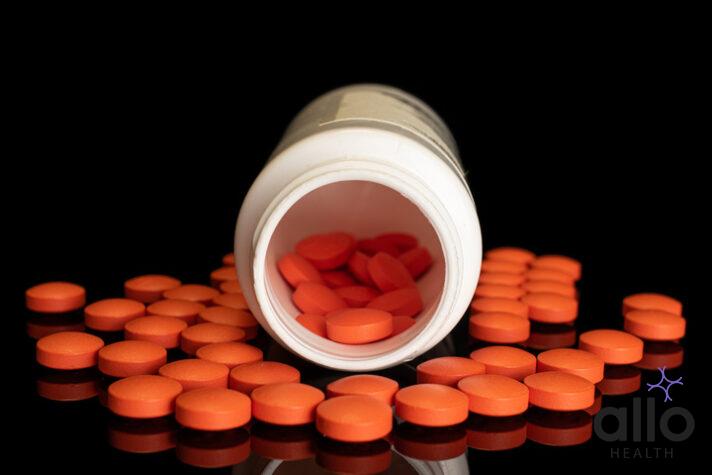Surprising Link Between Suboxone and Erectile Dysfunction: What You Need to Know

Allo Health is dedicated to personalized well-being, offering support and trusted information tailored to individual health goals. The platform emphasizes human-generated content, led by a distinguished medical team of experts, including physicians and sexual health specialists. Their commitment to credibility involves rigorous fact-checking, authoritative research, and continuous updates to ensure accurate, up-to-date information. Allo Health's unique approach goes beyond conventional platforms, providing expert-led insights and a continuous commitment to excellence, with user feedback playing a crucial role in shaping the platform's authoritative voice.

Dr Prachi holds an M.B.B.S Degree from NBMC, Darjeeling. She has gained extensive experience by working in various departments of several multispeciality hospitals. Her keen interest and knowledge in the field of sexual health enables her to address the concerns related to sexual wellness of the patients with utmost care and professionalism.
Why This Was Upated?
Our experts continually monitor the health and wellness space, and we update our articles when new information became available.
Updated on 17 April, 2024
- Article was updated as part of our commitment to diversity, equity, and inclusion.

"The following blog article provides general information and insights on various topics. However, it is important to note that the information presented is not intended as professional advice in any specific field or area. The content of this blog is for general educational and informational purposes only.
Book consultation
The content should not be interpreted as endorsement, recommendation, or guarantee of any product, service, or information mentioned. Readers are solely responsible for the decisions and actions they take based on the information provided in this blog. It is essential to exercise individual judgment, critical thinking, and personal responsibility when applying or implementing any information or suggestions discussed in the blog."
Dealing with opioid dependence is a challenging journey that often requires individuals to make tough decisions and seek effective treatments. One such treatment is Suboxone, a medication that has proven beneficial in helping people break free from the clutches of opioid addiction. While Suboxone offers hope and a path to recovery, it’s important to be aware of its potential side effects. One concern that has been raised is the possibility of Suboxone causing erectile dysfunction (ED), a condition that can significantly impact a person’s quality of life and intimate relationships. In this article, we will delve into this topic and explore the potential connection between Suboxone and ED, aiming to provide a balanced understanding of the issue at hand.
Understanding Suboxone
Suboxone is a medication commonly used in the treatment of opioid dependence. It is a combination of two active ingredients: buprenorphine and naloxone. Buprenorphine belongs to a class of drugs known as partial opioid agonists, which means it can activate the same receptors in the brain as opioids but with a milder effect. Naloxone, on the other hand, is an opioid antagonist that helps prevent misuse of Suboxone by blocking the effects of opioids if they are taken simultaneously. This combination makes Suboxone an effective tool in managing withdrawal symptoms and reducing cravings for opioids, aiding individuals in their journey toward recovery.
How Does Suboxone Work?
Suboxone is a medication used in the treatment of opioid dependence due to its ability to alleviate withdrawal symptoms and reduce cravings. Its working mechanism is based on the combination of two main active ingredients: buprenorphine and naloxone.
- Buprenorphine: Buprenorphine is a partial opioid agonist, which means it binds to the same receptors in the brain as opioids but produces a milder effect. Unlike full agonists like heroin or oxycodone, buprenorphine has a ceiling effect, meaning that its effects plateau even with increasing doses. This characteristic makes it less likely to cause the intense euphoria associated with other opioids and reduces the risk of overdose.
By binding to opioid receptors, buprenorphine helps alleviate withdrawal symptoms such as cravings, aches, nausea, and anxiety. It also helps stabilize brain chemistry and reduces the urge to use opioids by occupying the receptors without fully activating them.
- Naloxone: Naloxone is an opioid antagonist, meaning it blocks the effects of opioids by binding to the same receptors but without activating them. It is primarily added to Suboxone to deter misuse and prevent the potential for intravenous abuse. .
The combination of buprenorphine and naloxone in Suboxone creates a synergistic effect. Buprenorphine helps alleviate withdrawal symptoms and cravings, while naloxone helps prevent misuse and promotes safer use of the medication.
It’s worth noting that the naloxone component of Suboxone is poorly absorbed when taken orally, making it less likely to affect the therapeutic effects of buprenorphine. However, if the medication is misused by crushing and injecting it, the naloxone can become active and precipitate withdrawal symptoms.
Overall, Suboxone’s mechanism of action offers a balanced approach to managing opioid dependence, providing relief from withdrawal symptoms while minimizing the risk of misuse and overdose. However, it’s essential to use Suboxone under the supervision of a healthcare professional and follow the prescribed dosage to ensure its safe and effective use in addiction treatment.
Major Uses And Benefits of Suboxone
Suboxone, a medication used in the treatment of opioid dependence, offers several significant uses and benefits in helping individuals overcome addiction and achieve recovery. Here are some of the major uses and benefits of Suboxone:
- Withdrawal symptom management: Suboxone is highly effective in managing the challenging and often distressing symptoms of opioid withdrawal. It helps alleviate symptoms such as cravings, body aches, nausea, anxiety, and insomnia, allowing individuals to transition through the early stages of recovery with greater comfort and stability.
- Reduction of cravings: One of the primary benefits of Suboxone is its ability to reduce cravings for opioids. By binding to the same receptors in the brain as opioids but with a milder effect, Suboxone helps satisfy the brain’s desire for opioids while minimizing the intense euphoria and potential for abuse associated with other opioids. This reduction in cravings supports individuals in maintaining abstinence and avoiding relapse.
- Harm reduction: Suboxone plays a crucial role in harm reduction by replacing more dangerous opioids, such as heroin or illicitly obtained prescription opioids, with a safer alternative. Its partial agonist properties and the presence of naloxone help prevent the risk of overdose and lower the potential for misuse or injection, as naloxone can induce withdrawal symptoms if Suboxone is misused in this way.
- Long-term maintenance: Suboxone can be prescribed for long-term maintenance in opioid dependence treatment. It provides a stable and consistent dose of buprenorphine, allowing individuals to focus on rebuilding their lives, engaging in therapy, and addressing the underlying issues contributing to their addiction. Long-term maintenance with Suboxone can significantly increase the chances of sustained recovery and reduce the risk of relapse.
- Supportive care and counseling: Suboxone is typically used as part of a comprehensive treatment approach that includes counseling, therapy, and support services. By addressing the physical withdrawal symptoms and cravings, Suboxone helps individuals better engage in these supportive services and make the necessary behavioral and lifestyle changes for successful recovery.
- Accessibility and availability: Suboxone is available in various forms, such as sublingual films or tablets, which can be administered in an outpatient setting. This accessibility allows for flexible treatment options, reducing the need for lengthy hospital stays and providing individuals with the opportunity to maintain their daily routines and responsibilities while undergoing treatment.
It’s important to note that the use of Suboxone should always be supervised and prescribed by a qualified healthcare professional experienced in addiction medicine. Suboxone treatment is most effective when combined with comprehensive care that addresses the physical, psychological, and social aspects of opioid dependence.
Possible Side Effects of Suboxone
While Suboxone is generally considered safe and well-tolerated, like any medication, it can have potential side effects. It’s important to be aware of these side effects and discuss them with a healthcare professional before starting Suboxone treatment. Some possible side effects of Suboxone include:
- Nausea and gastrointestinal discomfort: One of the most common side effects of Suboxone is nausea, which may be accompanied by vomiting or stomach discomfort. These symptoms are typically mild and temporary, and they often improve over time as the body adjusts to the medication.
- Headache: Some individuals may experience headaches while taking Suboxone. These headaches are usually mild, but in rare cases, they can be more severe. If persistent or severe headaches occur, it’s important to inform a healthcare professional.
- Sleep disturbances: Suboxone can sometimes affect sleep patterns, causing insomnia or disrupted sleep. Some individuals may experience difficulty falling asleep or staying asleep during the initial stages of treatment. It is advisable to discuss any sleep-related issues with a healthcare professional to explore potential solutions.
- Sweating and flushing: Suboxone can cause excessive sweating or flushing of the skin in some individuals. These symptoms are generally temporary and resolve on their own.
- Dizziness and lightheadedness: Suboxone may cause dizziness or lightheadedness, particularly when standing up quickly or changing positions. It is important to move slowly and be cautious to prevent falls or accidents.
- Constipation: Like many opioid medications, Suboxone can cause constipation. This side effect is due to the slowing down of the digestive system. Drinking plenty of fluids, increasing fiber intake, and engaging in regular physical activity can help alleviate this issue. In some cases, a healthcare professional may recommend over-the-counter remedies or prescribe medication to manage constipation.
- Sexual dysfunction: In some individuals, Suboxone may lead to sexual side effects, such as decreased libido, erectile dysfunction (ED), or difficulty achieving orgasm. These effects are relatively uncommon and can be temporary or persist for the duration of treatment. It is important to communicate any changes in sexual function to a healthcare professional for appropriate management or adjustment of the treatment plan.
- Allergic reactions: While rare, allergic reactions to Suboxone can occur. Signs of an allergic reaction may include hives, rash, itching, swelling, or difficulty breathing. If any of these symptoms occur, immediate medical attention should be sought.
It’s important to remember that everyone’s response to medication can vary, and not all individuals will experience these side effects. Open communication with a healthcare professional is crucial to manage any side effects and determine the best course of action for an individual’s specific needs.
Things To Know Before Starting The Course Of Suboxone
Before starting a course of Suboxone, it’s important to have a comprehensive understanding of the medication and its implications. Here are some essential things to know before beginning Suboxone treatment:
- Consultation with a healthcare professional: Suboxone treatment should always be initiated under the guidance and supervision of a qualified healthcare professional experienced in addiction medicine. They will assess your medical history, current medications, and individual circumstances to determine if Suboxone is an appropriate treatment option for you.
- Complete disclosure of substance use: It’s crucial to provide honest and accurate information about your substance use history, including the type of opioids used, duration of use, and any other substances or medications taken. This information helps the healthcare professional tailor the treatment plan and determine the appropriate starting dose of Suboxone.
- Understanding the treatment plan: Before starting Suboxone, it’s important to discuss the treatment plan with your healthcare professional. This includes understanding the recommended dosage, frequency of administration, and the anticipated duration of treatment. It’s important to adhere to the prescribed treatment plan and not adjust the dosage without medical guidance.
- Medication interactions and precautions: Inform your healthcare professional about all medications you are currently taking, including prescription medications, over-the-counter drugs, and any herbal supplements. Some medications, such as benzodiazepines, may interact with Suboxone and require careful monitoring or dosage adjustments. Additionally, it’s essential to disclose any medical conditions you have, such as liver or kidney problems, as they may affect the use of Suboxone.
- Risks and benefits: Understand the potential risks and benefits of Suboxone treatment. While Suboxone can be highly effective in managing opioid dependence, it may have side effects and individual variations in response. Discuss these potential risks and benefits with your healthcare professional to make an informed decision about starting Suboxone treatment.
- Commitment to counseling and support: Suboxone treatment is most effective when combined with counseling, therapy, and support services. It’s important to be willing to engage in these additional components of treatment and actively participate in your recovery journey. These services can help address the underlying causes of addiction, develop coping strategies, and support long-term sobriety.
- Regular monitoring and follow-up: Regular monitoring and follow-up visits with your healthcare professional are essential during Suboxone treatment. These visits allow for dose adjustments, evaluation of treatment progress, and addressing any concerns or side effects that may arise. Follow the recommended schedule of appointments to ensure optimal support throughout your recovery process.
Remember, Suboxone treatment is a tool to aid in your recovery, but it’s not a standalone solution. It should be combined with a comprehensive treatment plan and lifestyle changes to support your journey towards long-term sobriety.
Dosage And Administration of Suboxone
The dosage and administration of Suboxone should be determined and closely monitored by a healthcare professional experienced in addiction medicine. The following information provides a general overview, but it is crucial to follow the specific instructions provided by your healthcare professional.
Dosage: The initial dose of Suboxone is typically based on the severity of opioid dependence and the individual’s previous opioid use. The goal is to find the lowest effective dose that helps alleviate withdrawal symptoms and reduce cravings. Typical starting doses range from 4mg/1mg to 8mg/2mg of buprenorphine/naloxone, with the numbers indicating the respective amounts of each active ingredient.
The dose may be adjusted during the first week of treatment to find the optimal dose for each individual.
Administration: Suboxone is available in oral film or oral tablet . Both are? sublingual forms, which means they should also be placed under the tongue and allowed to dissolve fully.
It is important to avoid eating, drinking, or smoking for at least 30 minutes before and after taking Suboxone, as these actions can affect the absorption and effectiveness of the medication.
Frequency of Administration: Suboxone is usually taken once daily. Your healthcare professional will provide specific instructions regarding the timing and frequency of doses. It is important to adhere to the prescribed schedule and not to adjust the dosage or frequency without medical guidance.
Duration of Treatment: The duration of Suboxone treatment varies depending on individual needs. Some individuals may require short-term use to manage withdrawal and initial recovery, while others may benefit from longer-term maintenance to support ongoing sobriety. Your healthcare professional will discuss and determine the appropriate duration of treatment based on your progress and goals.
Regular Monitoring and Adjustments: During Suboxone treatment, regular monitoring and follow-up appointments with your healthcare professional are essential. These visits allow for ongoing evaluation of your progress, assessment of any side effects, adjustment of the dosage if needed, and addressing any concerns or questions you may have.
It’s important to communicate openly with your healthcare professional regarding your response to the medication, any changes in symptoms, or any difficulties you may be experiencing. This allows for personalized adjustments to optimize your treatment plan and support your recovery.
Remember, the information provided here is a general overview, and individual dosing and administration instructions may vary. Always consult with a healthcare professional to receive personalized guidance and to ensure safe and effective use of Suboxone.
Side Effects of Suboxone
Suboxone, a medication used in the treatment of opioid dependence, can have potential side effects. While not everyone will experience these side effects, it’s important to be aware of them. It’s essential to discuss any concerns or potential side effects with a healthcare professional. Here are some possible side effects of Suboxone:
- Nausea and gastrointestinal discomfort: Nausea, vomiting, and stomach discomfort are common side effects of Suboxone. These symptoms are usually mild and tend to improve over time as the body adjusts to the medication.
- Headache: Some individuals may experience headaches while taking Suboxone. These headaches are typically mild, but in rare cases, they can be more severe. Inform your healthcare professional if you experience persistent or severe headaches.
- Sleep disturbances: Suboxone can sometimes affect sleep patterns, causing insomnia or disrupted sleep. Some individuals may experience difficulty falling asleep or staying asleep during the initial stages of treatment. Discuss any sleep-related issues with your healthcare professional to explore potential solutions.
- Sweating and flushing: Suboxone can cause excessive sweating or flushing of the skin in some individuals. These symptoms are generally temporary and resolve on their own.
- Dizziness and lightheadedness: Suboxone may cause dizziness or lightheadedness, particularly when standing up quickly or changing positions. It’s important to move slowly and be cautious to prevent falls or accidents.
- Constipation: Suboxone, like many opioid medications, can cause constipation. It’s advisable to maintain adequate hydration, increase fiber intake, and engage in regular physical activity to help alleviate this side effect. Your healthcare professional may recommend over-the-counter remedies or prescribe medication if necessary.
- Sexual dysfunction: In some individuals, Suboxone may lead to sexual side effects such as decreased libido, erectile dysfunction (ED), or difficulty achieving orgasm. These effects are relatively uncommon and can be temporary or persist for the duration of treatment. Discuss any changes in sexual function with your healthcare professional for appropriate management or adjustment of the treatment plan.
- Allergic reactions: Although rare, allergic reactions to Suboxone can occur. Signs of an allergic reaction may include hives, rash, itching, swelling, or difficulty breathing. Seek immediate medical attention if any of these symptoms occur.
It’s important to note that this is not an exhaustive list of side effects, and individual responses may vary. If you experience any concerning or persistent side effects while taking Suboxone, it is crucial to contact your healthcare professional for guidance and appropriate management.
What is Erectile Dysfunction?
Erectile dysfunction (ED), also known as impotency, is a condition characterized by the inability to achieve or maintain an erection firm enough for satisfactory sexual activity. It is a common condition that can affect men of all ages, but it is more prevalent in older men. Erectile dysfunction can have various underlying causes, including physical, psychological, or a combination of both.

Causes of Erectile Dysfunction
Erectile dysfunction (ED) can have various underlying causes, which can be physical, psychological, or a combination of both. Understanding these causes is essential in determining the appropriate treatment approach. Here are some common causes of erectile dysfunction:
- Physical factors:
- Cardiovascular conditions: Conditions such as atherosclerosis (narrowing of blood vessels), high blood pressure, and heart disease can impair blood flow to the penis, making it difficult to achieve or maintain an erection.
- Diabetes: High blood sugar levels can damage blood vessels and nerves, leading to impaired blood flow and nerve function in the penis.
- Obesity: Excess body weight can contribute to hormonal imbalances, cardiovascular problems, and reduced testosterone levels, all of which can impact erectile function.
- Hormonal imbalances: Low testosterone levels, often associated with aging, can contribute to erectile dysfunction.
- Neurological disorders: Conditions like multiple sclerosis, Parkinson’s disease, and stroke can affect the nerve signals necessary for achieving an erection.
- Medications and treatments: Certain medications, such as antidepressants, antihypertensives, and chemotherapy drugs, may have side effects that interfere with erectile function. Additionally, treatments for prostate cancer, including surgery and radiation therapy, can affect nerves and blood vessels involved in erections.
- Psychological factors:
- Stress and anxiety: Mental and emotional stressors, including work-related stress, performance anxiety, and relationship issues, can interfere with sexual arousal and performance.
- Depression: The mental health condition can reduce libido, affect hormone levels, and contribute to erectile dysfunction.
- Low self-esteem: Negative body image, lack of confidence, or past experiences of sexual trauma can impact sexual performance and lead to erectile difficulties.
- Lifestyle and behavioral factors:
- Smoking: Tobacco use can damage blood vessels and restrict blood flow, negatively impacting erectile function.
- Alcohol and substance abuse: Excessive alcohol consumption and substance abuse can impair nerve function, disrupt hormonal balance, and contribute to erectile dysfunction.
- Sedentary lifestyle: Lack of physical activity and poor overall health can contribute to obesity, cardiovascular problems, and hormonal imbalances, all of which can affect erectile function.
- Poor diet: Unhealthy eating habits, particularly diets high in processed foods and lacking in fruits, vegetables, and whole grains, can contribute to obesity, diabetes, and cardiovascular issues that impact erectile function.
It’s important to note that these causes are not exhaustive, and individual cases of erectile dysfunction may involve multiple contributing factors. Consulting with a healthcare professional, such as a urologist or primary care physician, is crucial for a thorough evaluation and diagnosis. They can help determine the specific underlying causes of erectile dysfunction and recommend appropriate treatment options, which may include lifestyle changes, counseling, medication, or other interventions.
Symptoms of Erectile Dysfunction
The primary symptom of erectile dysfunction (ED) is the persistent or recurrent inability to achieve or maintain an erection firm enough for satisfactory sexual activity. However, there are additional symptoms and signs that may accompany or contribute to the experience of erectile dysfunction. These include:
- Difficulty achieving an erection: One of the main symptoms of erectile dysfunction is the consistent difficulty in achieving an erection. This may involve not being able to get an erection at all or having erections that are not firm enough for sexual intercourse.
- Trouble maintaining an erection: Another symptom of ED is the inability to sustain an erection throughout sexual activity. A man may initially achieve an erection but then lose it before or during intercourse, making it challenging to engage in satisfactory sexual activity.
- Reduced sexual desire: While erectile dysfunction primarily relates to difficulties with achieving or maintaining an erection, it can also be accompanied by a decrease in sexual desire or libido. This can manifest as a decreased interest or motivation in engaging in sexual activity.
- Emotional distress and relationship strain: Erectile dysfunction can lead to emotional distress, frustration, and a sense of inadequacy or loss of self-esteem. It may also cause tension or strain in intimate relationships, leading to communication difficulties and decreased sexual satisfaction for both partners.
- Anxiety and performance-related stress: ED can trigger feelings of anxiety and stress, especially related to sexual performance. The fear of not being able to achieve or maintain an erection can create a self-perpetuating cycle of anxiety that further contributes to erectile difficulties.
- Reduced confidence and self-esteem: The inability to perform sexually as desired can significantly impact a man’s confidence and self-esteem, both in and out of the bedroom. This can affect overall well-being and may lead to avoidance of sexual encounters or intimacy.
It’s important to note that occasional difficulties with erections are common and may not necessarily indicate erectile dysfunction. However, if these symptoms persist or cause significant distress, it is advisable to consult with a healthcare professional, such as a urologist or primary care physician, for further evaluation and guidance. They can help identify the underlying causes of erectile dysfunction and recommend appropriate treatment options to address the issue.
Suboxone and Erectile Dysfunction: The Connection
There is evidence to suggest that Suboxone, a medication used in the treatment of opioid dependence, can potentially contribute to erectile dysfunction (ED) in some individuals. However, it is important to note that not everyone who takes Suboxone will experience this side effect, and the severity and duration of the effect can vary from person to person.
Suboxone contains two active ingredients: buprenorphine, a partial opioid agonist, and naloxone, an opioid antagonist. Buprenorphine helps to reduce opioid cravings and withdrawal symptoms, while naloxone is included to discourage misuse of the medication. While buprenorphine itself has a lower risk of causing sexual side effects compared to full opioid agonists, such as heroin or oxycodone, it can still have an impact on sexual function.
The exact mechanism by which Suboxone may contribute to erectile dysfunction is not fully understood. However, it is believed to involve the influence of opioids on the central nervous system and hormonal balance. Opioids can affect the release of certain hormones, including testosterone, which plays a crucial role in sexual function and libido. Lower levels of testosterone can lead to decreased sexual desire, difficulty achieving or maintaining an erection, and other symptoms of erectile dysfunction.
It’s important to consider that other factors associated with opioid dependence and its treatment may also contribute to erectile dysfunction. These factors include the underlying physical and psychological effects of opioid use, the presence of co-occurring medical conditions, lifestyle factors, and the overall impact of addiction on relationships and emotional well-being.
If you are experiencing erectile dysfunction while taking Suboxone, it is important to discuss this with your healthcare professional. They can evaluate your specific situation, review any potential contributing factors, and explore possible treatment options. Adjustments to the Suboxone dosage, switching to an alternative medication, or incorporating additional therapies may be considered to address both the opioid dependence and the sexual side effects.
Lifestyle Tips To Manage Opioid Dependance
Managing opioid dependence involves a comprehensive approach that combines medical treatment, psychological support, and lifestyle changes. Here are some lifestyle tips that can help support your journey towards recovery from opioid dependence:
- Seek professional help: Start by seeking professional help from healthcare providers experienced in addiction medicine. They can guide you through the treatment process, provide medication-assisted treatment (MAT) options such as Suboxone, and offer counseling or therapy services.
- Build a support system: Surround yourself with a supportive network of family, friends, or support groups who understand your challenges and can provide encouragement and accountability. Consider joining a local support group or attending meetings such as Narcotics Anonymous (NA) or SMART Recovery.
- Establish a routine: Developing a structured daily routine can help provide stability and purpose. Plan activities, work, exercise, meals, and rest periods to create a sense of normalcy and reduce idle time that may lead to cravings or relapse.
- Focus on healthy nutrition: Eating a well-balanced diet can contribute to your overall well-being and aid in recovery. Include a variety of fruits, vegetables, whole grains, lean proteins, and healthy fats in your meals. Avoid excessive sugar, caffeine, and processed foods, as they can affect mood and energy levels.
- Engage in regular exercise: Regular physical activity has numerous benefits for both physical and mental health. Exercise can help reduce stress, improve mood, boost energy levels, and promote better sleep. Find activities you enjoy, such as walking, cycling, swimming, or yoga, and incorporate them into your routine.
- Practice stress management techniques: Find healthy ways to cope with stress and manage emotions, as stress can be a trigger for cravings. Consider techniques such as deep breathing exercises, meditation, mindfulness, journaling, or engaging in hobbies or activities that bring you joy and relaxation.
- Avoid triggers and high-risk situations: Identify and avoid situations, people, or environments that may trigger cravings or temptations to use opioids. It may involve making changes to your social circle, avoiding certain places, or creating a safety plan for high-risk situations.
- Focus on self-care: Prioritize self-care activities that promote physical, mental, and emotional well-being. This may include getting enough sleep, practicing good hygiene, engaging in activities you enjoy, spending time in nature, or seeking therapy or counseling to address underlying issues.
- Develop healthy coping mechanisms: Instead of turning to opioids in times of stress or discomfort, explore alternative coping mechanisms. This can include seeking support from loved ones, engaging in hobbies, practicing relaxation techniques, or participating in activities that bring you joy and a sense of fulfillment.
- Set realistic goals: Set achievable goals for yourself, both short-term and long-term. Breaking down larger goals into smaller, manageable steps can help you stay motivated and build confidence as you make progress in your recovery.
Remember, everyone’s journey to recovery is unique, and it’s important to consult with healthcare professionals for personalized guidance and support. Adopting a healthy lifestyle, along with medical treatment and emotional support, can contribute to your overall well-being and increase your chances of successfully managing opioid dependence.
Treatment Practices For Erectile Dysfunction
When it comes to the treatment of erectile dysfunction (ED), several approaches are available, depending on the underlying causes and individual circumstances. Treatment practices for ED can include:
- Lifestyle changes: Making certain lifestyle modifications can have a positive impact on erectile function. These may include maintaining a healthy weight, exercising regularly, eating a nutritious diet, managing stress levels, reducing alcohol consumption, quitting smoking, and getting enough sleep.
- Psychological counseling: If psychological factors such as stress, anxiety, or depression contribute to ED, counseling or therapy sessions with a qualified mental health professional can be beneficial. Cognitive-behavioral therapy (CBT) and other therapeutic approaches can help address underlying psychological issues and improve sexual performance.
- Medications: There are several oral medications available, known as phosphodiesterase type 5 (PDE5) inhibitors, that can be prescribed to enhance erectile function. Examples include sildenafil (Viagra), tadalafil (Cialis), vardenafil (Levitra), and avanafil (Stendra). These medications work by increasing blood flow to the penis, facilitating the achievement and maintenance of an erection. It’s important to note that these medications require a prescription and should be used under medical supervision.
- Vacuum erection devices (VEDs): A VED is a non-invasive device that creates a vacuum around the penis, drawing blood into the organ and causing an erection. Once the erection is achieved, a constriction band or ring is placed at the base of the penis to maintain the erection during sexual activity.
- Penile injections or intraurethral suppositories: In some cases, medications can be directly injected into the side of the penis or inserted into the urethra to promote blood flow and induce an erection. These methods are typically used when oral medications are not effective or not suitable for an individual.
- Penile implants: For individuals who do not respond to other treatments, surgical options like penile implants may be considered. Penile implants involve the placement of inflatable or semi-rigid devices into the penis, allowing the individual to manually achieve an erection.
- Hormone replacement therapy: If hormonal imbalances, such as low testosterone levels, contribute to ED, hormone replacement therapy may be an option. Testosterone replacement therapy can help improve sexual function in some individuals with low testosterone levels.
It’s important to consult with a healthcare professional, such as a urologist or primary care physician, to determine the most appropriate treatment approach based on your specific needs and medical history. They can evaluate the underlying causes of your erectile dysfunction and guide you towards the most suitable treatment options, taking into account factors such as overall health, potential side effects, and personal preferences.
Frequently Asked Questions
Q: Can Suboxone cause other sexual side effects?
A: Yes, Suboxone can potentially cause other sexual side effects, such as reduced libido or difficulty in reaching orgasm. However, these side effects are not experienced by everyone who takes the medication.
Q: What should I do if I’m experiencing erectile dysfunction while on Suboxone?
A: If you’re experiencing ED while on Suboxone, it’s crucial to talk to your healthcare provider. They can help determine whether the ED is a side effect of Suboxone or if it’s due to other factors.
Q: Are there alternative medications that have a lower risk of causing erectile dysfunction?
A: While different medications used in medication-assisted treatment (MAT) for opioid dependence may have varying risks of causing erectile dysfunction, it is best to consult with your healthcare provider to determine the most suitable medication for your specific needs. They can consider your medical history, treatment goals, and potential side effects to guide you towards an appropriate medication choice.
Q: Can adjusting the dosage of Suboxone help with erectile dysfunction?
A: In some cases, adjusting the dosage of Suboxone may help alleviate erectile dysfunction. Your healthcare provider can evaluate your response to the medication and consider making dosage adjustments if necessary. However, it’s important to discuss any changes with your healthcare provider before adjusting your medication regimen.
Q: Will all individuals who take Suboxone experience erectile dysfunction?
A: No, not all individuals who take Suboxone will experience erectile dysfunction. The occurrence of this side effect can vary depending on individual factors, such as dosage, duration of treatment, and pre-existing conditions. Other factors, including psychological aspects, lifestyle factors, and co-occurring medical conditions, can also contribute to the development of erectile dysfunction.
Conclusion
The relationship between Suboxone and erectile dysfunction is complex and multifaceted. While there is a potential link, many factors can contribute to erectile dysfunction, including both physical and psychological conditions. If you’re taking Suboxone and experience ED, it’s crucial to consult with your healthcare provider. There are many treatment options available for ED, and your healthcare provider can guide you to the best one for your situation.
Remember, your health and well-being are of paramount importance. Don’t hesitate to seek help if you’re experiencing any health concerns. Knowledge is power, and we hope this article has empowered you with the understanding you need to take control of your health.
Disclaimer: Any information provided is for educational or informational purposes only and should not be considered a substitute for professional medical advice, diagnosis, or treatment. If you have questions or concerns about a particular medication or treatment, please consult with a licensed healthcare provider who can evaluate your individual situation and provide personalized recommendations. It is important to always follow the instructions of your healthcare provider and read the medication label before taking any medication.
Sexual health is as important as physical and mental health. In most cases, one consultation can go a long way. Personalised, discreet, and judgement-free treatment at your fingertips – book an online consultation with one of Allo?s leading experts.






































